Mobile Ivy Bridge and ASUS N56VM Preview
by Jarred Walton on April 23, 2012 12:02 PM ESTThe LCD: One of the Better Offerings
There are a few things we need to reiterate with the LCD before we run the numbers. First, this is a good panel from LG—it’s the LP156WF1 (A1). You get a matte surface, 1080p resolution, decent color gamut (exceeding the sRGB color space), and a maximum brightness that can certainly be used outdoors. That’s all great, but there’s a catch: we don’t know if this panel will actually ship on all, some, or none of the N56VM models. We hope it’s the first option, but most likely it will be the second, and we’ll be very unhappy if the 1080p panel gets pulled in favor of a cheaper 1366x768 display. So while we’ll present the numbers below, just make sure you check on the panel resolution if nothing else before purchasing a retail N56VM laptop. With that out of the way, here’s how the LG Philips display compares to other LCDs.
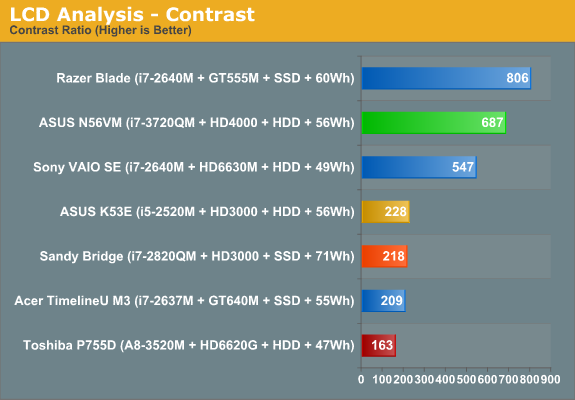

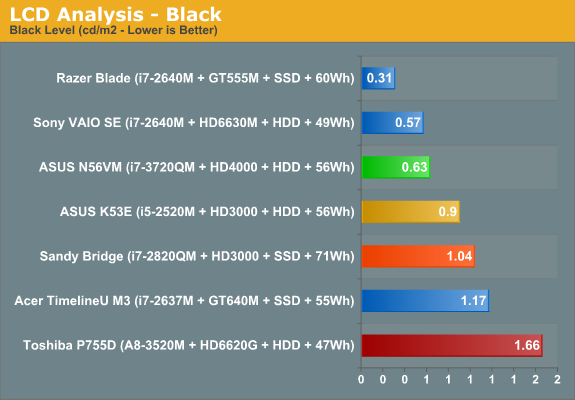
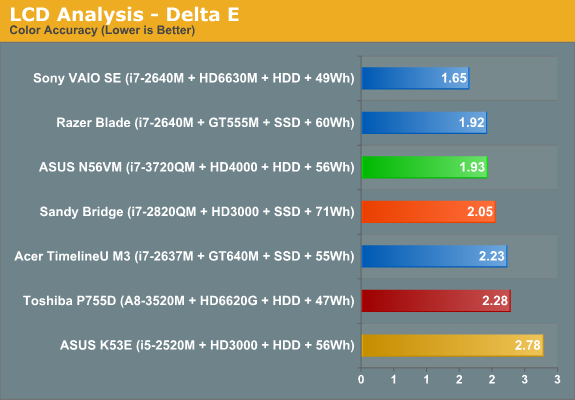
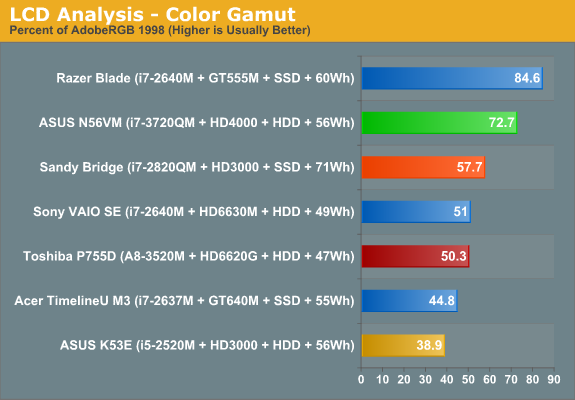
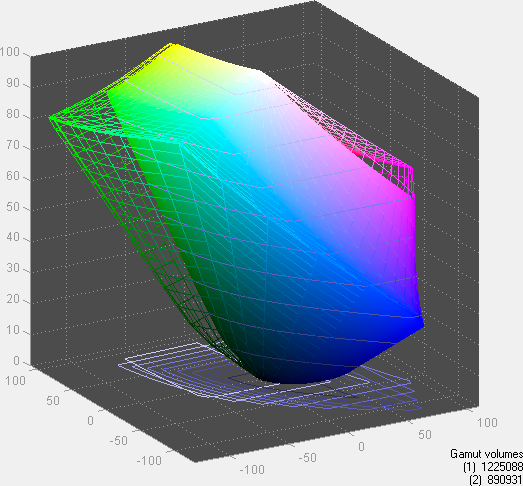
Overall, this is a well balanced LCD for a 15.6” laptop. It can get very bright, which is always a plus for laptops that might be used outside or on public transportation, the contrast is good, and the colors are good as well. The AU Optronics B156HW01 v4 is still a better LCD in some regards, with a higher color gamut and better post-calibration colors, but we wouldn’t complain about using the LP156WF1.
Viewing angles aren’t quite as good as the AUO display either, but outside of IPS, PLS, or *VA panels you simply won’t get excellent vertical viewing angles. And there’s the rub: the IPS display used in the Sony VAIO SE and HP Envy 15 has great viewing angles, but color gamut is a bit low and that results in colors that aren’t quite as good as a high-end TN panel, at least in theory. The problem is that TN panels get color shift unless you’re in a narrow viewing arc, so ultimately we prefer the wide viewing angles of IPS even if it means slightly lower scores elsewhere.















49 Comments
View All Comments
krumme - Tuesday, April 24, 2012 - link
Whatever the benefit is, we dont see it now.Failure - hands down.
JarredWalton - Tuesday, April 24, 2012 - link
FUD, hands down.BSMonitor - Monday, April 23, 2012 - link
http://www.anandtech.com/show/4313/intel-announces...At these power levels, the benefit is not as noticeable.
The benefit comes in the extreme low power envelope. None of the mobile processors released today are of that variety.
mgoldshteyn - Monday, April 23, 2012 - link
So much for lighter laptops with Ivy Bridge.mgoldshteyn - Monday, April 23, 2012 - link
With a mere 6-cell battery, to boot!JarredWalton - Monday, April 23, 2012 - link
Lighter laptops are a design decision by the OEM, not the CPU. Putting in switchable graphics and all the other stuff adds weight, but ASUS chose to go for a more affordable product rather than spending a lot of time and money on industrial design and weight. I don't think you'll see IVB end up being heavier on average compared to SNB, but there's no inherent reason for it to be lighter either. Use more efficient and lighter cooling materials along with lighter materials for the chassis and you could certainly get a 15.6" IVB laptop down to 4.5 lbs., but you could do that with SNB as well (e.g. the Sony VAIO SE).mabellon - Monday, April 23, 2012 - link
That's because Intel has only launched the desktop line and high end mobile chips. The CPUs destined for ultrabooks, the super efficient IVB chip (~17W) launch was delayed.--------
The initial release includes 13 quad-core processors, most of which will be targeted at desktop computers.
Further dual core processors, suitable for ultrabooks - thin laptops - will be announced "later this spring".
[http://www.bbc.com/news/technology-17785464]
gorash - Monday, April 23, 2012 - link
Nice... if only MacBooks had those specs with that price. I don't really need the optical drive though.dwade123 - Monday, April 23, 2012 - link
And these companies continues to make crappy laptops. Seriously, with power efficient Ivy Bridge and no discrete GPU, they sure have terrible battery life. This is why Macbooks are one of the better laptops out there and deserves to be the model which others copies.xpsuser - Sunday, May 13, 2012 - link
I have a HP DVT8 (weighs a ton with the regular battery). I bought it for the 18" screen and blu ray player - unfortunately the HP software (for blu ray/DVD playback) is full of bugs! I got the Dell XPS17 about a year ago. Dell knows how to make a laptop - it has the extended battery (lasted about 5.5 hrs new), it is light (I can easily carry it with one hand - could barely do that with the HP!) they use Cyberlink PowerDVD for viewing Blu Ray/DVDs (no problems!). I like the Dell but I don't like the lack of choices - by that I mean I can't opt out of their anti-virus choice, etc.